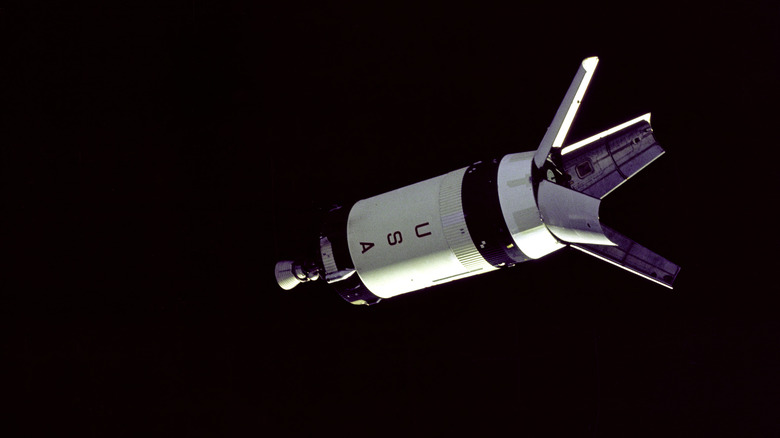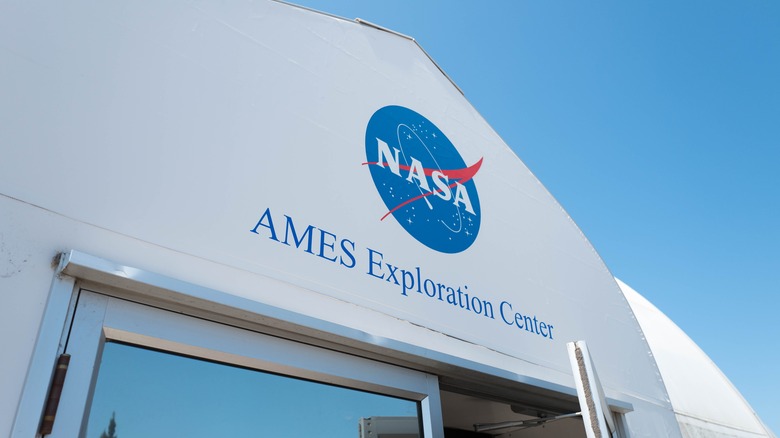Things Fly Me To The Moon Just Ignores About The Moon Landing
The moon landing has been questioned for years, with conspiracies like the "shadows" and "no stars" theories shedding doubt on various parts of the mission. Flat earthers have even pointed to such doubts as support for their belief that the Earth couldn't possibly be round. At the center of most of these theories about a fake moon landing is the belief that the U.S. government cannot be trusted and would go to any lengths to create a narrative that bolsters its image.
"Fly Me to the Moon" released in July 2024 and paints a fictional story about NASA staging a fake moon landing amid the Cold War in case the real attempt doesn't work out. Pulling from historical events, figures, and organizations, it weaves together a tale of reality and fiction that can be tough to untangle. Here are the things "Fly Me to the Moon" ignores about the real moon landing.
Apollo 7 first used the camera and telecast
In "Fly Me to the Moon," the first television camera and first live lunar telecast were used on Apollo 11, the mission that first landed humans — Commander Neil Armstrong and Lunar Module Pilot Buzz Aldrin — on the moon in July 1969. But this technology was actually first used on Apollo 7 (above) over half a year earlier in October 1968. According to "Fly Me to the Moon" director Greg Berlanti, the decision was made in the interests of narrative.
"[We have] the usual historical fiction liberties, and then also, general narrative liberties you take, even with some of the stuff that actually did occur, augmenting it slightly if it helped our story," he told Entertainment Weekly. "We made it Apollo 11 because that would be more significant for our narrative," he later added, referring to the first camera and telecast. Television cameras were used on all Apollo missions after 7, with 7 and 8 both using the RCA slow-scan model.
NASA's public relations campaign wasn't as ruthless
In "Fly Me to the Moon," President Richard Nixon's government enlists the help of NYC ad executive Kelly Jones (Scarlett Johansson) to help NASA concoct a fake moon landing. The motivation is one that might make sense — it's the Cold War, and the United States can't risk failure on the world stage amid the Space Race that saw the country battle the Soviet Union for "technological and intellectual superiority," as Royal Museums Greenwich put it. But in reality the agency did not attempt to create a fake moon landing, and its real public relations campaign wasn't as ruthless as in the movie.
"NASA had a really healthy public affairs program in the 1960s, but their job wasn't necessarily or totally to sell the benefits of the space program or to convince people this investment was worthwhile," Brian Odom, NASA's chief historian, told Smithsonian Magazine. "It really was to communicate transparently what the work of the agency was — to be there at launches and to project those to the country and to the world." Bill Barry, NASA's chief historian from 2010 to 2020, who consulted on the movie's script, echoed these sentiments. "There was no special effort to 'sell' the Apollo program — especially not one aimed at raising funds for the agency either directly or indirectly," he told TIME.
While some people who worked on the moon mission did create advertising campaigns and press kits, they worked for private contractors. NASA gave them permission to conduct these campaigns, but they acted separate from the agency. The Apollo 11 PR team was also made up of former news reporters — not cutthroat marketers willing to do anything to succeed like Johansson's character.
The real conspiracies suggest another ploy
As mentioned, "Fly Me to the Moon" suggests that the United States wanted to fake the moon landing to beat the Soviet Union in the space race. America didn't want its rival perceived as the superior superpower, and its communist government better than democracy. And many who believe the moon landing was faked would likely say something similar (or that it was meant to divert attention from the disastrous Vietnam War).
Peter Knight, author of "Conspiracy Culture: From the Kennedy Assassination to 'The X-Files,'" points to Bill Kaysing's self-published 1976 book — "We Never Went to the Moon: America's Thirty Billion Dollar Swindle" — as the origin of the theory. Kaysing claims that NASA couldn't make President John F. Kennedy's pledge to put a man on the moon by the end of the 1960s, so it faked the moon landing. A former U.S. naval officer with connections to the U.S. space program, however questionably (he was a technical writer), was the perfect conduit for such claims at the time. Conspiracies about JFK's assassination had already made headway in the 1960s, and the end of the decade marked the beginning of a period when trust in the U.S. government began to decline amid the Vietnam War and Watergate scandal.
But the movie deviates slightly from Kaysing's theory. He claimed NASA didn't have the technology to reach the moon, so it filmed a fake moon walk in a film studio. Afterward, it sent astronauts into orbit and broadcast the footage. The movie instead portrays the alleged scheme as more of a fallback — should the mission fail, the agency has footage to broadcast to cover up its botched attempt.
Apollo 11's launch director has a different story
Cole Davis (Channing Tatum) is Apollo 11's spaceship launch director in "Fly Me to the Moon." Though there was no real-life Davis, his character draws on Apollo 11's actual flight director, Gene Kran. But while Davis' character was head of the Apollo 1 fire that killed three astronauts, Kranz was not, and he wasn't at the scene of the accident either. "I was the flight director of the previous day's test, and I did the morning test, and then I handed it over to Chris Kraft," the aerospace engineer told Click2Houston.
In the movie, Davis also makes the call to land the Eagle on the moon. It's a controversial decision, given that it only has 8% fuel to leave Earth's only natural satellite, and he lies to hide the risk from the crew. In real life, it wasn't Kranz who made the call — it was the astronauts. The team decided to go against the protocol of aborting the mission at the 60-second mark and found a place to land in the nick of time. "We heard the call of 60 seconds, and a low-level light came on," Buzz Aldrin told London's Science Museum. "That, I'm sure, caused concern in the control centre. They probably normally expected us to land with about two minutes of fuel left. And here we were, still a hundred feet [30 m] above the surface, at 60 seconds."
NASA secured funding eight months before the mission
One of the plot points in "Fly Me to the Moon" is NASA's struggle to get funding for Apollo 11. Just eight months before the mission, the agency is scrambling as marketing and engineering teams work together to convince Congress to approve a budget. But in real life NASA had enough money by this time — the mission's budget was increased from $19.5 billion in 1964 to $22.7 billion in 1966. The entire project cost $21.3 billion, so the agency ultimately remained under budget. In "NASA's First 50 Years: Historical Perspectives," Steven J. Dick's claims it was Project Gemini — the United States' second human spaceflight program — that had issues securing funding. Gemini was a bridge between the first program, Project Mercury, and the later Apollo missions, and it aimed to train astronauts for the latter.
The movie also implies that the Apollo 11 mission received funding from sponsorship deals, but Richard Jurek — co-author of "Marketing the Moon: The Selling of the Apollo Lunar Program" — told Time that this never happened. According to the agency's site: "As a government agency, NASA will not promote or endorse or appear to promote or endorse a commercial product, service or activity." NASA historian Billy Barry told Time that astronauts who have endorsed products only do so when they're no longer employed by NASA.





